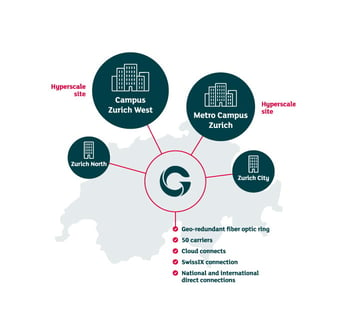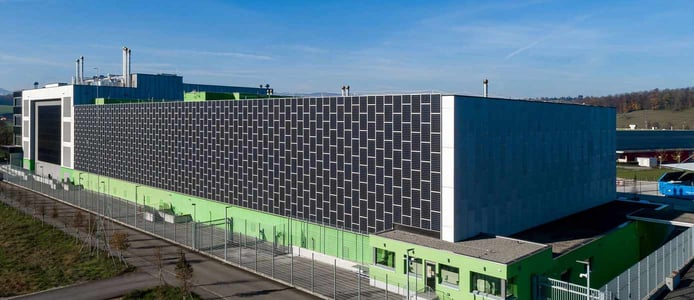
TL; DR: Green began as an internet service provider (ISP) in rural Switzerland and has grown into a company that connects much of Europe. Its services range from residential internet to corporate datacenter use cases. Green offers a mix of web and email hosting, private and shared IaaS products, telephony, and data-protection tools. Its focus on service and choice distinguishes it from many enterprise cloud providers that offer more rigid structures.
In 1995, the Swiss Farmers’ Union launched agri.ch, an internet service provider focused on connecting rural regions of Switzerland. In 2002, agri.ch expanded its coverage and services by building a datacenter and rebranding to Green. The company expanded its network to offer fiber-optic connections, and by 2018, it offered an Infrastructure-as-a-Service business model through Switzerland’s first high-performance datacenter.
It has been quite a journey from serving rural Switzerland to connecting individuals and businesses throughout Europe, but Green has always been focused on the future.
“We still see innovation as the best way to build sustainable solutions, and it is our vision to establish Switzerland as a leading data hub in the heart of Europe,” said Marco Stadler, CMO/CSO of Green. “Today, Green aims to use its creativity and vision to move our digital future forward.”

Green helps businesses in Switzerland and throughout Europe connect with the world.
Over the years, Green emancipated itself from the farmers union. Green now serves both households and businesses. On the residential side, it offers a mix of internet, television, digital telephone services, web and domain hosting, and Microsoft Exchange accounts. Hosting for residential customers is typically shared, with significant support for email accounts, online databases, and a visual site designer for web pages.
For businesses, Green offers colocation and datacenter services with a mix of public and private cloud services, web hosting, dedicated servers, private and shared IaaS, and a mix of data-protection tools.
Its blend of corporate and residential services that span software and hardware sets Green apart. The sheer scale of its diverse offerings allows the company to satisfy many use cases, some of which require significant under-the-hood capabilities. And Green continues to build its operation and network to support even more customers throughout Europe.
“We are heavily invested in expanding our datacenter footprint as well as other infrastructure, including a connectivity backbone and cloud platform,” Marco said.
Optimizing Customer Core Competencies for Successful Cloud Migration
The trend in corporate IT has been business leaders ceding more infrastructure to providers, limiting in-source work where possible.
“Big analysts like Gartner predict that by 2025, 80% of the IT workloads will be produced out of commercial datacenters or the cloud,” Marco said.
Enterprises want to outsource services through IaaS or SaaS and focus on their core competencies. In the long term, cloud solutions are more secure and agile than traditional IT setups.
Green maintains the strategic flexibility to hone in on those core competencies across different industries and enterprise sizes. In an increasingly competitive market, it’s not enough to provide commodity cloud or hosting services. The total value-add must be compelling enough to entice companies to outsource their core IT functions.
“Our advantage certainly lies in identifying our customers’ needs,” he said. “We pride ourselves in providing professional solutions for residential users and small businesses as well as for large-scale companies.”
Perhaps the most significant leverage point lies with initial cloud migrations. Any vendor can set up new accounts and services for a newly onboarded corporate client. However, a partner like Green, which focuses on that hard-to-define core competencies, translates a new client’s IT needs in line with business and corporate goals. That approach means every migration is evaluated individually instead of being treated like a checklist.
For example, a medium-sized health care business may be looking for alternatives to running company-owned servers. A typical step would be to either purchase rack space or simply migrate applications and data to servers in a professional datacenter.
However, Green is more sensitive to the long-term needs of such businesses and helps to develop an individual exit strategy for the journey to the cloud. This approach takes existing IT infrastructure and industry solutions as well as legal requirements into consideration. The right strategy can minimize cost while improving performance for complex operations.
Swiss Cultural Model Enhances Business Partnerships
One of Green’s biggest strengths is its company culture — as shaped by that of Switzerland. The Swiss are known for efficiency, privacy, and not playing favorites.
“It’s all about choice and support,” Marco said. “We are a Swiss-based company that represents Swiss values. In that sense, we position ourselves as cloud, carrier, and technology neutral. Our clients have the choice of what and how much they would like to source and how much they manage themselves. We support them on their journey to cloud with everything we have to offer.”
That approach empowers Green’s customers with the best of both worlds. On one hand, they have a wide latitude in selecting the products and services that complement their corporate goals and core competencies. On the other hand, Green’s commitment to personalized service means that each customer gets appropriate guidance and individualized support. That freedom plus support mindset streamlines onboarding and makes long-term business partnerships more collaborative.

Green deploys the latest technology in its state-of-the-art Swiss datacenters.
Green also stays updated on both industry trends and client feedback to fine-tune its strategic road map.
“When it comes to new services, we work very closely with the biggest hyper-scale technology as well as with innovative SMB enterprises,” Marco said. “Together with our partners, we think ahead to develop new services and solutions to shape the digital future.”
Green enhances partnerships through its network of agents, resellers, and cloud ecosystem partners. Its dedicated Cloud Marketplace connects Green clients to IaaS, PaaS, and SaaS providers. A mix of consultants, hyperscalers, software vendors, integrators, cloud platforms, hardware vendors, and security firms participate in the marketplace.
Migrations to the cloud or a distributed-computing environment have escalated in recent years, with estimates suggesting that a significant chunk of IT workloads will be outsourced to dedicated service providers within the next decade.
That trend implies that datacenters and large-scale MSPs must diversify their product offerings, moving from a commodity-services model to something more individualized to the core competencies of each client.
Green: Combining Best-in-Class Infrastructure with Dedicated People
Green’s offerings boil down to choice and support. The company competes in both individual and business markets, with product lines ranging from base internet connectivity to large-scale dedicated server deployments.
Green continues to adjust its own internal product and service road map to respond to customer needs and emerging tech trends.
“We are about to strengthen our performance and georedundancy,” Marco said. “Our newest project — the Zurich Metro Campus — will include three high-performance datacenters and an extensive business park with office facilities for our customers and related trade. We will provide a georedundant hyper-scale campus for our customers to connect their data to the cloud.”
Solutions like a business park aren’t just a nice bonus; they can serve as a critical overflow facility for business continuity after a natural disaster or some other dislocation to the client’s physical workspace. Coupled with on-site access to core data, that offering is part of a growing trend of being a comprehensive disaster-recovery solution provider.
Yet Green is as committed to a single residential client as to a massive enterprise.
“We make technological innovations accessible for everybody,” Marco said. “They need performance on a very different scale, of course, but with Green, they all profit from the same new advances in technology.”
HostingAdvice.com is a free online resource that offers valuable content and comparison services to users. To keep this resource 100% free, we receive compensation from many of the offers listed on the site. Along with key review factors, this compensation may impact how and where products appear across the site (including, for example, the order in which they appear). HostingAdvice.com does not include the entire universe of available offers. Editorial opinions expressed on the site are strictly our own and are not provided, endorsed, or approved by advertisers.
Our site is committed to publishing independent, accurate content guided by strict editorial guidelines. Before articles and reviews are published on our site, they undergo a thorough review process performed by a team of independent editors and subject-matter experts to ensure the content’s accuracy, timeliness, and impartiality. Our editorial team is separate and independent of our site’s advertisers, and the opinions they express on our site are their own. To read more about our team members and their editorial backgrounds, please visit our site’s About page.



